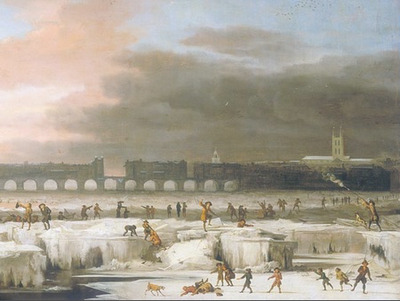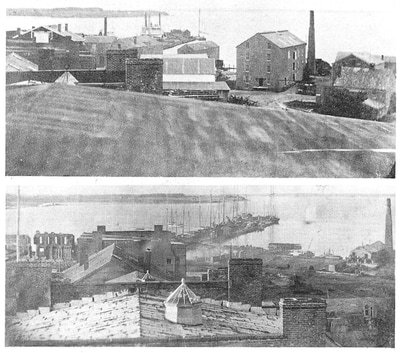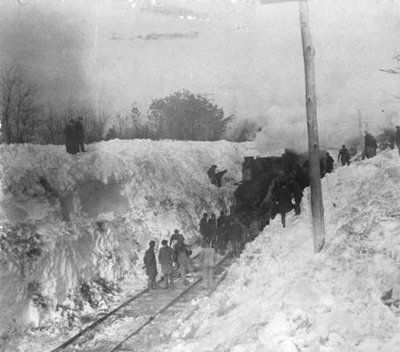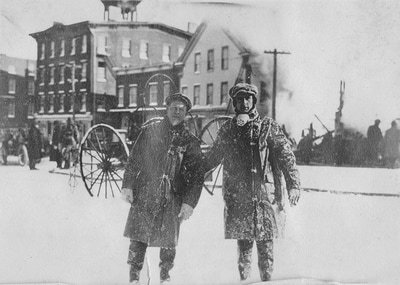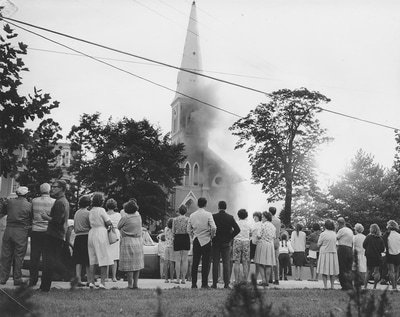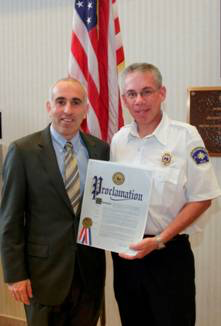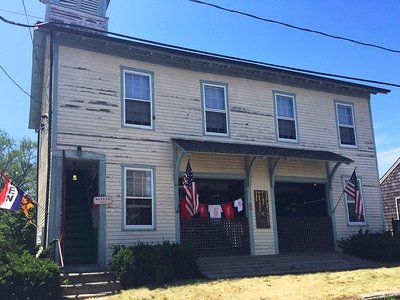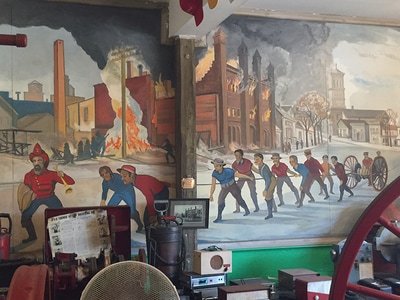FIRE & WATER: THE GREAT DISASTERS OF SAG HARBOR
Fire and Water, a largely virtual tour, will take you through some of Sag Harbor’s most trying times. Besides the economic woes that have befallen the Village when the whaling industry collapsed, for instance, there were also disasters that changed the whole face and texture of the village, like the great New Year’s Day fire of 1925 and the infamous Hurricane of 1938. Throughout, the Sag Harbor Fire Department, formed in 1803, has kept watch and done its best to keep disasters from becoming total devastation. We are proud of their history and grateful for their courage and vigilance.
We thank Sag Harbor Fire Chief Tom Gardella and former Chief Tom Horne for sharing historical information, and historian Jean Held and the Sag Harbor Historical Society for their invaluable assistance in obtaining many fascinating photographs of the Fire Department and the disasters cited in this tour.
-

THE YEAR WITHOUT A SUMMER
-

THE SAG-HARBOR FIRES OF 1817 AND 1845
-

THE FIRES THAT ENDED THE DEPRESSION
-

THE GREAT WHITE HURRICANE: THE BLIZZARD OF 1888
-

THE GREAT FIRES OF 1915 AND 1925
-

THE EARLY DAYS OF THE SAG HARBOR FIRE DEPARTMENT
-

"THE LONG ISLAND EXPRESS": THE GREAT HURRICANE OF 1938
-

RECENT DISASTERS, AND THANKS TO OUR AMBULANCE CORPS AND POLICE DEPARTMENT
-
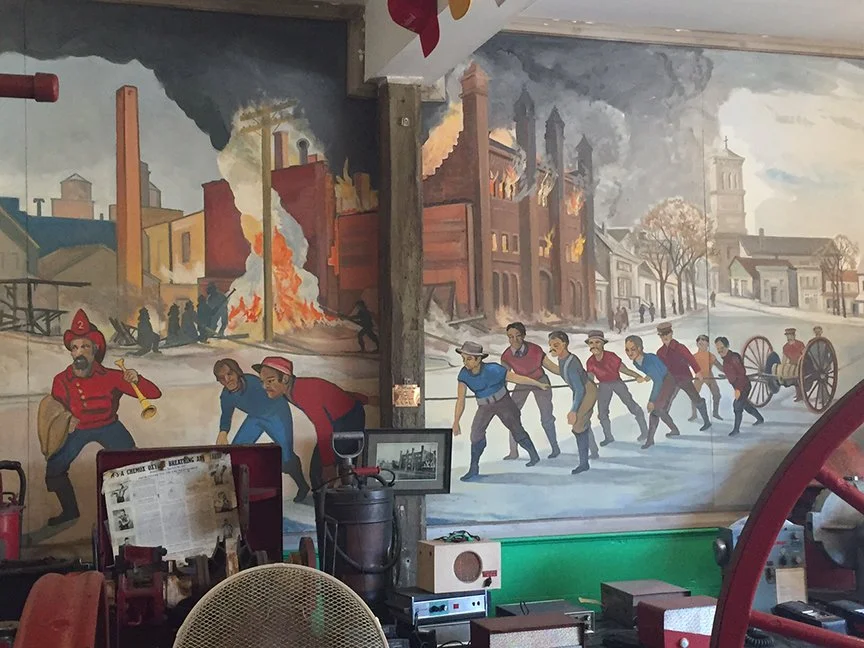
THE FIREMEN’S MUSEUM AND THE SHFD TODAY
Tambora Today
Great September Gale in Providence, RI *
Ice Skating on the Thames *
Tambora Eruption Lithograph *
.
THE YEAR WITHOUT A SUMMER
Fire and Water, a largely virtual tour, will take you through some of Sag Harbor’s most trying times. Besides the economic woes that have befallen the Village when the whaling industry collapsed, for instance, there were also disasters that changed the whole face and texture of the village, like the great New Year’s Day fire of 1925 and the infamous Hurricane of 1938. Throughout, the Sag Harbor Fire Department, formed in 1803, has kept watch and done its best to keep disasters from becoming total devastation. We are proud of their history and grateful for their courage and vigilance.
We thank Sag Harbor Fire Chief Tom Gardella and former Chief Tom Horne for sharing historical information, and Jean Held and the Sag Harbor Historical Society for their invaluable assistance in obtaining many fascinating photographs of the Fire Department and the disasters cited in this tour.
Old Sag-Harbor Lithograph *
Fire Bell from Firemen’s Museum ‡
Lithograph of Sag Harbor from a painting by Orlando Boars *
THE SAG-HARBOR FIRES OF 1817 AND 1845
As if things hadn't been bad enough in the two preceding years with a devastating gale and an endless winter, in the spring of 1817 came the first of Sag Harbor's great fires of the 19th Century.
Historian Henry Hedges, in an address delivered before the Sag-Harbor Historical Society on February 4th, 1896 from Early Sag-Harbor, read from a personal account: "A most calamitous event took place in this Port on Monday last. About 2 o'clock in the afternoon, a small barn in which there was some hay, was discovered to be on fire. The barn was contiguous to the thickest part of the settlement. The buildings were all wood, and very dry, and the wind blowing almost a gale. Such was the rapid progress of the flames that notwithstanding the utmost exertion of the citizens, in three hours about twenty of the best houses and most valuable stores in the place, together with fifteen barns, and other buildings were consumed... "...This awful visitation of Providence has left a number of families and poor widows houseless and dependent upon the charity of the public; has reduced others from a state of comfort and ease to poverty, and has greatly lessened the means of the rich, by consuming much of that capital they were employing for their own benefit and that of their fellow citizens."
Hedges then followed with an accounting of the Fire of 1845 from the "Corrector"", Sag Harbor's newspaper at the time. This fire had the added horror of taking place on November 14th, just before winter, wiping out provisions: "The fire in this village commenced about half-past 12 on Friday morning in a commission room for furniture and other articles, in the Suffolk buildings, and destroyed the hotel (Oakley's) and stores; Hunting's store, with the three dwellings at the west side of it, thence down the wharf as far as there were any buildings, on both sides, then the store of A. H. Gardiner, Phelps' Hotel, and everything up the street, on both sides, stopping after burning Tinker & Sons' on the east side, and A. G. Hedges' on the west, as likewise a number of dwelling houses and other buildings on the streets east of Main Street, and we are not much out of the way when we assert that there were somewhat in the neighborhood of ninety-five dwelling houses, stores, warehouses, number of dwelling houses and other buildings on the streets east of Main Street, and we are not much out of the way when we assert that there were somewhat in the neighborhood of ninety-five dwelling houses, stores, warehouses, tradesmen's shops, etc., destroyed; turning out over forty families to seek shelter in houses already fully stocked, or abide the peltings of the winter's storms; besides a good number being thrown entirely out of business, or their business much damaged.... The night was remarkably fine, and but little wind, until the air was so rarified by the excessive heat of the flames as to create a strong current..."
The Corrector then names over 88 "sufferers" among which some names well known to us still, including a J. Hildreth, Havens, French, the Suffolk Co. Bank, L'Hommedieu, Cooper, Gardiner, Halsey, Mulford, Rogers, Wade, Vail, and many others. D
octor Abel Huntington, Collector of the Port, declared that brick buildings north of Union Street "saved" Sag-Harbor, but obviously it had suffered extreme loss.
Before and After Fire of 1877 †
Remains of Cotton Mill †
Map of 1877 Fire †
Leather Fire Bucket *
THE FIRES THAT ENDED THE DEPRESSION
On February 18, 1877, the third of Sag Harbor's major conflagrations swept the wharves and business section of the Village, destroying 31 buildings, including the music hall, Nassau House Hotel, the Flour mill (which became the Sag Harbor Grain Company and later Grumman, where parts for the Lunar Landing Module were produced), residences on Rysam Street, and the remaining whaling warehouses. One firefighter’s excerpt gives a vivid picture: “A furious wind and snow storm were raging and the night was bitter cold. The water in the two street wells was soon exhausted and the boys backed the old ‘Minnehaha’ engine into the bay at the slip west of Huntting’s block and stood in freezing water knee deep pumping for dear life, relayed by citizens, as the members dropped out one by one from sheer exhaustion. With little water, meager equipment and exhausted fighting force, the fire raged out of control.” (from American Beauty, by Dorothy Ingersoll Zaykowski)
This fire was followed in 1879 by the Cotton Mill mysteriously burning, which made room for French immigrant and watchcase manufacturer Joseph Fahys to relocate his factory here in 1881. Fahys' factory was the Village’s employment mainstay thereafter until it was closed during the Great Depression, in 1931. The Village leased the second floor to a subsidiary of the Bulova Watch Company, and in 1937 citizens formed a committee to raise money for renovations and new machinery, and production increased to around 30,000 watchcases per week, until Bulova occupied the whole building. This also led to a housing boom between 1885 and 1915, with approximately 80 small factory workers’ houses being built in Sag Harbor.
At its lowest ebb in the mid-1870s, Sag Harbor’s population had dropped to slightly over 2,000. In 1907, the Brooklyn Eagle observed that “Sag Harbor has awakened from its moribund condition that followed the decline of the whaling industry and become a bustling manufacturing village of from 4,500 to 5,000 population, but not as important relatively as fifty years ago.”
Digging Out the LIRR †
Blizzard Magazine *
Madison Ave after the Blizzard *,
Old Tinted Postcard Making the Most of a Mess †
THE GREAT WHITE HURRICANE: THE BLIZZARD OF 1888
1888 was marked by a legendary snowstorm, starting the 11th of March and lasting three days, which was nicknamed the “Great White Hurricane". It crippled New England from Chesapeake Bay to Maine. The New York Times described it as “a tornado of wind and snow”. Ships sunk at sea, wires went down, stopping all communication, and transportation was immobilized. Conditions were horrible in Manhattan as well as eastern Long Island. From the New York City Subway’s website, G.J. Christiano wrote:
"One man suffered a gash on his forehead when he fell into a snow drift. The drift was soft and deep, but his head struck the leg of a dead horse buried there. For some time afterward, the man showed his friends the wound and boasted that he was the first person ever kicked by a dead horse...
In the suburbs, the snow drifts reached fantastic heights. A man living on Long Island had to leave his house to buy some needed groceries. He set out on a homemade pair of snowshoes for a store about a mile away. He walked on top of snowdrifts, but did not realize how huge they were. Then he looked down and saw some very tall trees. He realized that the drifts were about sixty feet high!
It was many weeks before the last signs of the deepest snow drifts disappeared. It was reported that one tremendous drift lasted until July!"
And for a description of the blizzard’s effect in Sag Harbor, from the book Voices of Sag Harbor: A Village Remembered (edited by Nina Tobler), is this accounting by Larry Burns, a Sag Harbor native:
"My grandmother, Mary Keating, had a member of her family who was a whaler during the whaling days. She remembered the blizzard of 1888 in SH, which left four to five Ft of snow. It was called the Great Blizzard, and everything was buried under the snow for days. Mary remembered a neighbor of hers who gave birth to a premature baby, named Len Roberts. It was so cold during the storm that the only way to keep the baby warm and alive was to put him in the oven, on one of the grates. He survived and went on to reach 100 years old."
The Alvin Silver Company †
Two Views of the Alvin Company †
Fire and Firemen After the 1915 Fire †
After the Great Fire of 1925 †
THE GREAT FIRES OF 1915 AND 1925
There is a curious architectural connection between the Fires of 1915 and 1925. If you look at the first photo here of the aftermath of the "Bikeshop" Fire of 1915, the building to the right of the destroyed building, which was relatively unscathed, was, ironically, the start of the Great Fire of 1925, or the Alvin Silver Fire. The Alvin Silver Company, housed in a huge building just south of Washington St, employed a substantial number of Sag Harbor residents, and its products were renowned.
Again, from Zaykowski’s book American Beauty, we have this account:
“It was a frigid, blustery winter’s night. The residents of Sag Harbor had just ushered in the New Year with celebrations and the customary whistle-blowing at the midnight hour. January 1, 1925 had arrived, and with it another disastrous fire. About 3 AM, fire was discovered in the Ballen Store annex on Washington Street. By 3:30am Ballen’s annex fell to the ground with a crash, sending sparks and embers into the air and onto the roofs of nearby structures. As the blaze progressed, Ballen’s stock of ammunition, shells and cartridges exploded, creating what was described as a scene from a war zone, and sending spectators in all directions. Linemen from the Sag Harbor Electric Light and Power Company climbed the icy poles to cut electric wires and shut off the current. Hoses were placed in holes cut into the ice, at the foot of Main St, and stretched to the scene. It provided an ample supply of water but turned out to be no match for the gale force winds which fanned the flames. Alvin Silver Company’s yellow pine interior caught fire and burned furiously.”
In spite of the cold, the blaze from the Alvin Silver Fire was so intense that windows across Main Street cracked from the great heat. Zaykowski continues:
"The massive brick structure stood doomed. Heat became too intense for the fire fighters to place ladders against the building, and they watched, in disbelief, as the place succumbed in the blaze. For more than 20 years the decorative facade stood, with the wooden panels beneath its graceful arches used for an honor roll to hold the names of those serving in WWII. In 1950 the place was purchased by Bohack and a supermarket built on the site.”
Washington St Firehouse of 1895 †
Hose Demo at Mashashimuet Park †
Church St. Fire House †
Men of the Murray Hill Fire Col †
King Juvenile Hook & Ladder Co, photo by William Howard †
THE EARLY DAYS OF THE SAG HARBOR FIRE DEPARTMENT
Sag Harbor has the fine distinction of having the first Volunteer Fire Department in the State of New York, having been chartered in 1803. Before pump hoses and fire hydrants, all residents of Sag Harbor were expected to keep leather buckets in their households to help form fire brigades, and were fined 50 cents if they were found to be lacking. Fires in wooden buildings, and especially those storing whale oil, were notoriously hard to put out, and it took an especially courageous person, then as now, to tackle them. We offer these wonderful early photos of the Sag Harbor Fire Department to give you a sense of our previous first responders.
Of special note is that William Howard, the Sag Harbor Fire Chief at turn of the 20th C, was also a gifted photographer who provided many of the invaluable historical photographs that grace this tour, as well as many of the Eastville Community Historical Society's “Collective Identity” photographs, featured here in the tour “Eastville Community: Unique Diversity”.
Old Whalers’ Afterwards †
Destruction on Main St †
The Old Whalers’ Church Steeple Before the Long Island Express †
"THE LONG ISLAND EXPRESS": THE GREAT HURRICANE OF 1938
This story of this disaster begins in Africa.
The storm's very first recorded indications were wind shifts, observed by the French in the Sahara Desert on September 4th, at Bilma Oasis. As the disturbance moved west off the African coast, it picked up tremendous speed, and by September 16th a Brazilian freighter in the Atlantic reported weathering winds of 74 mph or faster, hurricane force. Storm warnings were issued in Florida, but the storm seemed to turn and it was thought that it would peter out in the mid-Atlantic.
Even the best forecasters were fooled by the speed of this storm. Across New England there had been prior rainfall, and streams and rivers were full to their banks. The tide was already extremely high, it being the autumnal equinox. As the storm swept by the coast at winds greater than 60mph, twice as fast as normal, it tore up parts of Atlantic City’s boardwalk.
By this time the eye of the storm was 50 miles wide, and it continued northward into New England at more than 50mph, hardly slowing down as it hit land. It arrived here on Wednesday, September 21, at about 2:30pm. When the hurricane and its tidal surge hit Long Island, and its impact registered on seismographs in Alaska. The east side of the vortex had speeds approaching 100mph, with gusts measured in Long Island Sound at 120mph.
A letter quoted by his wife Dorothea in famous weatherman Richard Hendrickson’s book Paumanok: Winds of the Fish’s Tail, recounts trying to get home from work in Bridgehampton and the following day:
“You never saw such a mess in your life… Lumber Lane was a mass of fallen trees. I climbed over at least 15 monsters to get home. Most of them I had to climb up, sit on, and slide down the other side, because the trunks were so huge…Thursday we did a little driving around. The wrecked houses, barns, churches, and the trees down are a pathetic sight… I got through to Sag Harbor to deliver my food orders Thursday afternoon. It was 13 miles instead of the usual 4 from my house… The beautiful steeple of the Presbyterian Church… is shattered. At its top used to hang the light which guided the whaling vessels back to their home port. A light was always kept burning there even in recent years. That’s one landmark that will be missed terribly around here… The whole town of Sag Harbor is terribly wrecked. The Methodist Church Steeple toppled over on to the back end of the house of one of my relief clients. That same house is smashed in in front by a huge tree which also smashed the son’s car. I suppose you’ve heard about the tidal wave at West Hampton Beach. That Mrs. John King that was drowned was a very good friend of the Hendricksons’..."
Dune Road in Westhampton was almost totally devastated, and as noted in almost every account of the storm, the loss of the massive 185 ft steeple from Sag Harbor’s National Historic Landmark, the First Presbyterian (Old Whalers’) Church, quickly became a hallmark of its destructive force.The storm's aftermath can still be seen, in a sense, because the Old Whalers' Church steeple, beacon of homecoming to citizens and sailors out at sea since 1844, was never rebuilt. Ironically, Minard Lafever, architect of the church, had built it with the possibility of devastating storms in mind, and had left a clever gap between the base of the church and its steeple for the wind to pass beneath. Parishioners found the moaning of the wind through the gap distracting and stuffed the gap, sealing its destruction during the Long Island Express and also causing it to collapse numerous tombstones in the Old Burying Ground beneath it.
The hurricane was estimated to have killed 682 people, damaged or destroyed 57,000 homes, and caused property losses estimated at the equivalent of $4.7 billion today. As terrifying as Superstorm Sandy was, for Sag Harbor the Long Island Express still bears the dubious honor of being our most devastating storm.
St Andrews Church Fire †
Hurricane Carol, 1954 *
Flood from Superstorm Sandy ‡
Proclamation to Ambulance Corps §
RECENT DISASTERS, AND THANKS TO OUR AMBULANCE CORPS AND POLICE DEPARTMENT
We haven’t been unscathed since the Long Island Express made landfall here. In 1954 Hurricane Carol, a category 3 hurricane, caused devastation in the Northeast, and was followed by lesser hurricanes Donna (1960), Gloria (1985), Bob (1991), and then Superstorm Sandy in 2012, which killed 5 people in the northeast and left power out for days for most of us. Quite a powerhouse. Fires have not been so frequent, as safety precautions and fire-fighting techniques have improved, but there was, of note, the Saint Andrews Church Fire in August, 1965, and in 1994 the Easter Fire on Main Street, mostly affecting the Emporium Hardware store and Marty’s Barber Shop, a well-loved fixture of the village. Both had to be rebuilt. As the New York Times reported, "The building north of the store, though severely damaged, remained standing. Its owner, Marty Trunzo, had been cutting hair on the ground floor for 54 years in his barbershop.”
The building also housed a camera shop, an apartment and two offices, including one where Thomas Harris wrote much of 'Silence of the Lambs.’” Besides running Marty’s Barber Shop, Mr. Trunzo helped start the Firemen’s Museum and had himself been a volunteer fireman for most of his long life.
After Superstorm Sandy, the Sag Harbor Volunteer Ambulance Corps received a special proclamation from the Suffolk County Legislator for their heroic work in its aftermath. The Ambulance Corps had immediately rushed to assist the Broad Channel Fire Department of Queens, NY, which had lost its entire fleet due to flooding. It filled a retired 2002 ambulance with donations from local residents, organized by Sag Harbor Village Police Chief Tom Fabiano, which included clothing, food, toiletries, and a check in the amount of $1200 to assist in Broad Channel’s recovery efforts. The Corps not only delivered the goods, but left the retired ambulance to the Broad Channel’s department. Our hats are off to our Ambulance Corps and Police Department, and our First Responders in general, in perpetuity.
Firemen’s Museum ‡
Murray Hill Fire House ‡
Mural of 1915 and 1925 Fires ‡
THE FIREMEN’S MUSEUM AND THE SHFD TODAY
We were proud to honor our Firemen's Museum, at the corner of Church and Sage Streets, but after the death of its leader Tom Horne in 2019, it was closed and fell into some delapidation. However, we are excited to announce that our intention at the Sag Harbor Partnership, working with the Village on whose land the building sits, to renovate and restore the buildins as a Firehouse Museum. We are pleased to announce that plans for fundraising and development have begun, and we invite your support.
We must end this tour by honoring the truly extraordinary Sag Harbor Volunteer Fire Department. Its history is commemorated in its Firemen’s Museum at the corner of Church and Sage St. The Department consists of 5 Companies: Gazelle Hose Co. No. 1, Montauk Hose Co. No. 2, Otter Hose Co. No. 3, Murray Hill Hose Co. No. 4, and Phoenix Hook & Ladder Co. No. 1. The department has 3 Squads: Heavy Rescue; Fire Police, and a Dive/Water Rescue Team. The SHFD actively engages in the community and teaches children how to prevent and handle fires.
The Murray Hill Fire House at Elizabeth and Division Streets is one of the oldest firehouses in the country (1893). What will become the new Sag Harbor Firehouse Museum had been built in 1833 as an extension for use by the Presbyterian Church, as that church was being constructed, and served many community purposes before its closure a few years ago, having been maintained as the Firemen's Museum since 1974. We look forward to re-introducing it to the public, and particularly the children of the East End, after its renovation and re-opening! It will maintain the lively spirit of its previous self, and we seek to honor our Sag Harbor Volunteer Fire Department while telling some of the stories of the Department's fabled and courageous past.



